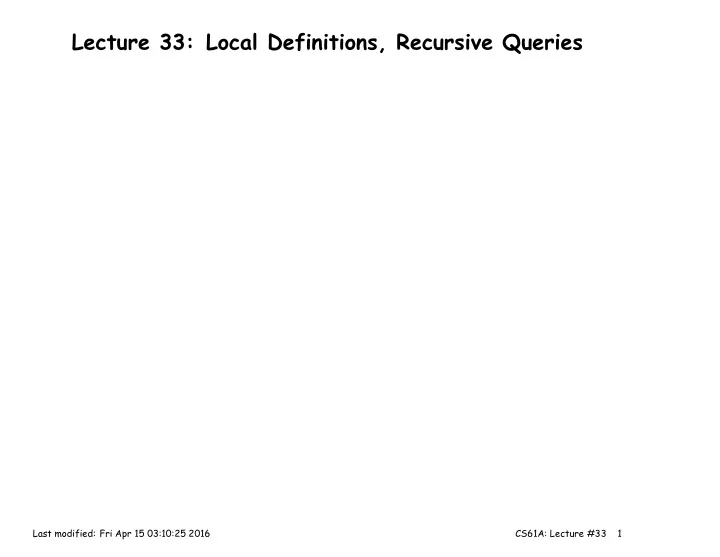

Lecture 33: Local Definitions, Recursive Queries Last modified: Fri Apr 15 03:10:25 2016 CS61A: Lecture #33 1
Local Tables • SQL provides a way to create (essentially) a temporary table for use in one select. • Analogous to the let expression in Scheme. • Here, foreigner is a one-column table local to this statement. people with foreigner(person) as ( parent child select "Martin" union Martin George select "Christina" union Christina George select "Johanna" George Martin F ) Johanna Martin F select child from people, foreigner George N Paul where people.parent = foreigner.person; George N Ann George N John What does this do? Martin F George N Martin F Robert Martin F Donald Donald Peter Last modified: Fri Apr 15 03:10:25 2016 CS61A: Lecture #33 2
Example: Ancestry Relationships • What does the program on the left do? • (distinct removes duplicate rows.) people with kin(first, second) as ( parent child select a.child, b.child Martin George from people as a, people as b Christina George where a.parent = b.parent George Martin F and a.child != b.child ) Johanna Martin F select distinct kin.second, child George N Paul from people, kin George N Ann where kin.first = parent; George N John Martin F George N Martin F Robert Martin F Donald Donald Peter Last modified: Fri Apr 15 03:10:25 2016 CS61A: Lecture #33 3
Recursion, Yet Again • As with Python, Scheme, and streams, (limited) recursion is possible in SQL using the with clause. • General form: with table_name ( column_names ) as ( select ... union -- Base case select ... union -- Base case select ... from ..., table_name , ... ) select ... • The recursively defined table must appear only once in the from clause of the last select in the with clause. • Because of these restrictions, no mutual recursions or tree recur- sions are allowed. Last modified: Fri Apr 15 03:10:25 2016 CS61A: Lecture #33 4
Example: Integers • Define the table ints to contain integers from 1–30: create table ints as with ints(n) as ( select 1 union select n+1 from ints where n<=30 ) select n from ints; • Here, I’ve chosen to use ints for both the local and global tables. • Usual sort of scope rules apply: the local ints is distinct from the global one, so I didn’t have to make up a new name. Last modified: Fri Apr 15 03:10:25 2016 CS61A: Lecture #33 5
Defining Ancestor Recursively • An ancestor is a parent or an ancestor of a parent. with related(ancestor, descendant) as ( select parent, child from people union select ancestor, child from related, people where descendant = parent ) select ancestor from related where descendant = "Paul"; Last modified: Fri Apr 15 03:10:25 2016 CS61A: Lecture #33 6
A Famous Number • There is a famous story about the “interesting’ number 1729, the first of the “taxicab numbers.” • Given our table ints (numbers up to 50) how do we find them? Last modified: Fri Apr 15 03:10:25 2016 CS61A: Lecture #33 7
Recommend
More recommend